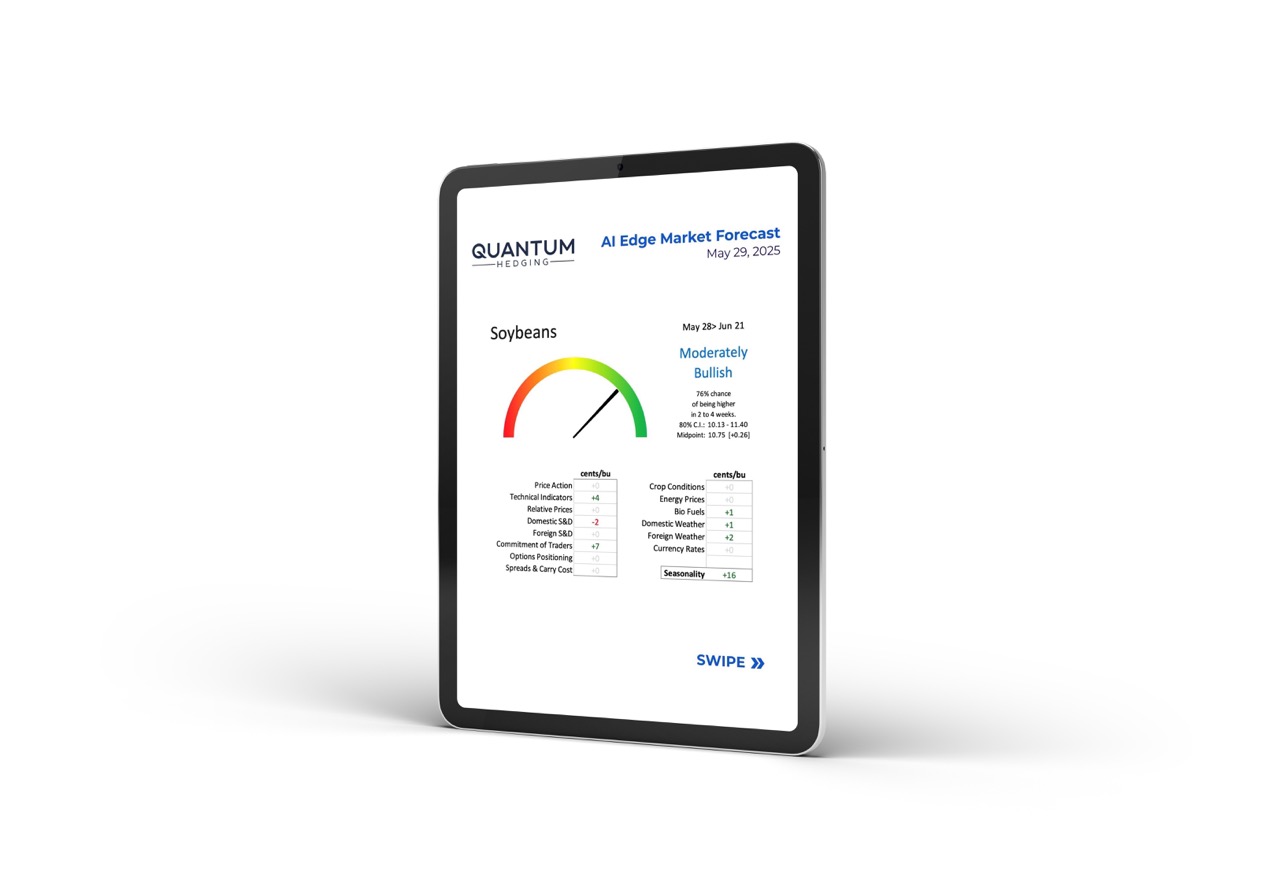Grain markets have always relied on forecasts, but until recently, these models were built using a limited set of data points—mainly weather patterns, acreage reports, and yield estimates or technical indicators like the Relative Strength Index (RSI) or moving averages. This simplified approach worked for a time, but today’s complex global markets require more robust forecasting tools.
Enter artificial intelligence (AI), which transforms forecasting by enabling the ingestion and analysis of hundreds of new data features. AI doesn’t just enhance the speed of analysis—it allows grain forecasters to incorporate a much broader range of market drivers, from 4 to over 400, like supply and demand, macroeconomic conditions, technical indicators, and inter-commodity relationships. With AI, we can unlock insights previously hidden within vast datasets, giving farmers, elevators and investors the edge they need to stay ahead.
Expanding the Scope: From 4 to 400+ Data Features
Traditional grain forecasting models were limited by the manageable amount of data a human broker could process. With AI, this bottleneck disappears. Today’s models can aggregate data from diverse sources across five critical domains:
-
Supply & Demand Dynamics: Detailed reports on planting progress, export trends, carryout stocks, and regional consumption patterns offer a more nuanced picture of availability and demand pressures.
-
Macroeconomic Factors: Currency exchange rates, interest rates, and global trade policies—especially between major importers and exporters—play an outsized role in commodity prices. AI can efficiently integrate these macro signals.
-
Inter-Commodity Relationships: AI enables forecasting models to account for cross-commodity correlations, such as how soybean prices influence corn futures or how shifts in energy markets impact fertilizer costs and, in turn, crop economics.
-
Technical Indicators: Machine learning models analyze historical price movements, trading volumes, and trend signals, helping traders identify potential price shifts before they occur.
-
Market Structure & Sentiment: AI tools can also ingest market depth data, open interest, and even sentiment indicators from news feeds and analyst reports to capture how expectations shape market behavior.
The ability to analyze hundreds of features in real-time contributes to forecasts being more comprehensive but also more adaptive to evolving market conditions.
AI excels in recognizing complex, nonlinear relationships between multiple variables—patterns that are hard to spot with traditional statistical methods. For instance, while weather is still a crucial factor, the impact of a drought in the U.S. on wheat prices may depend on global macroeconomic shifts, changes in crude oil prices, and regional planting decisions. AI-powered models can process these connections holistically to deliver more accurate predictions.
These insights aren’t static; machine learning ensures the models evolve. As new data flows in—from satellite imagery, trade reports, or commodity exchanges—AI systems refine their algorithms, improving accuracy over time.
Real-Time Forecasting and Market Adaptability
Markets move fast, and grain forecasting needs to keep pace. AI platforms process real-time data streams, offering immediate updates to market participants. This agility is especially valuable when unexpected events—such as trade sanctions, transportation strikes, or weather anomalies—create sudden shifts in supply and demand.
With dynamic forecasting models, grain traders can act on updated predictions within minutes, locking in prices or adjusting positions to minimize risk. This is a game-changer for stakeholders operating in volatile markets, where timing is everything.
More precise forecasts lead to better decision-making. AI-driven insights empower producers, buyers, and traders to make smarter, data-informed moves, such as:
-
Farmers: Optimize planting schedules, adjust crop mix, and secure inputs based on anticipated demand shifts.
-
Elevators: Hedge against price risks by monitoring currency fluctuations, interest rates, and trade policy signals.
-
Investors: Use inter-commodity signals to create more sophisticated trading strategies and take advantage of arbitrage opportunities.
The integration of technical indicators and market structure data also allows participants to anticipate price movements and trade entry points with greater confidence.
With AI tools handling hundreds of data features, market participants are better prepared for uncertainty. By capturing interdependencies among factors such as weather, economic conditions, and global trade flows, AI helps make forecasts that are not only forward-looking but resilient.
This multi-faceted approach allows stakeholders to prepare for scenarios that older models might miss. For example, if a shift in energy markets increases fertilizer costs, AI forecasts will flag the potential impact on grain production, pricing, and input supply.
Forecasting for the Future
The shift from 4 to 400+ data points marks a new era in grain forecasting. With AI at the core, forecasting isn’t just about predicting prices—it’s about making better decisions, faster, and with greater precision. From tracking supply and demand dynamics to analyzing inter-commodity relationships, AI brings clarity to complexity, transforming how agriculture and commodity markets operate.
In a world where margins are tight and volatility is constant, having the ability to analyze and act on nuanced market signals is the ultimate advantage. With AI, that advantage is now within reach for anyone ready to embrace data-driven forecasting.
Dr. Kevin McNew is an agricultural economist dedicated to advancing the use of technology in agriculture. With extensive experience across academia, business, and entrepreneurship, he focuses on innovative approaches to forecasting and market intelligence.
Ready to transform your grain marketing strategy?
At Quantum Hedging, we specialize in helping clients build effective grain marketing strategies, leveraging data, benchmarks, and cutting-edge AI predictive analytics and machine learning techniques to maximize returns and manage risk.



